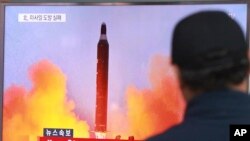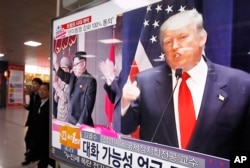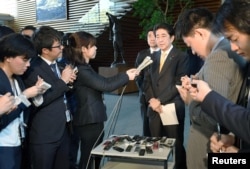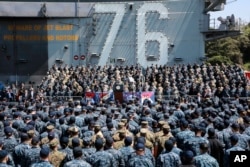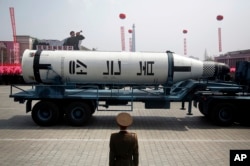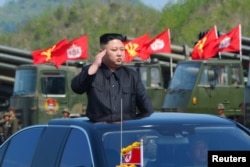What is the controversy surrounding North Korea?
Washington and Pyongyang have moved closer to the brink of conflict over the growing nuclear threat on the Korean Peninsula.
Since North Korea conducted its fourth nuclear test in January 2016, neither Washington nor Pyongyang seem willing to make any conciliatory gestures. Under former President Barack Obama, the U.S. rallied international support for increased sanctions against the North Korean government.
Pyongyang responded by accelerating nuclear and ballistic missile tests.
Earlier this month at a massive military parade in Pyongyang, North Korea showed off what appeared to be new forms of ballistic missile technology, which it hopes will soon be capable of delivering a nuclear warhead to the continental United States.
President Donald Trump has further increased pressure by emphasizing possible military strikes to prevent North Korea from developing an intercontinental ballistic missile capable of striking the U.S. mainland.
What is the United States doing to address escalating tensions on the Korean Peninsula?
Trump and U.S. officials have repeatedly said all options remain "on the table" to deal with further North Korean provocations.
Trump said the Security Council must be prepared to impose additional and stronger sanctions on North Korea's nuclear and ballistic missile programs.
"North Korea is a big world problem, and it's a problem we have to finally solve," Trump said recently. "People have put blindfolds on for decades, and now it's time to solve the problem."
The comments came after Trump made his latest round of separate telephone calls to the leaders of Japan, China and Germany to discuss concerns about North Korea.
Which countries are involved?
Trump has had discussions with the leaders of Japan, China and Germany about the threat posed by North Korea.
A phone call this week between Trump and Japanese Prime Minister Shinzo Abe was meant to increase pressure on Pyongyang not to engage in further provocative actions, but was not prompted by any significant change in the situation, according to officials in Tokyo.
Abe also said he and Trump agreed that a larger role in dealing with Pyongyang should be played by China.
Trump subsequently spoke to Chinese President Xi Jinping about North Korea. In their conversation Sunday, the Chinese president said he hopes all sides avoid doing anything to worsen the tense situation on the Korean peninsula, according to the Xinhua news agency.
In addition, the U.S. and China are launching four rounds of talks, as Trump heads to China later this year in a visit aimed at strengthening cooperation to reduce tensions in the Korean Peninsula.
What is being done to address the nuclear problem in North Korea?
The United Nations slapped economic sanctions on North Korea for its nuclear and ballistic missile programs and is now considering tougher measures, including a global ban on Air Koryo, the country's state-run airline, to punish North Korea for its continuing weapons tests.
During his visit to the North Korean border earlier this month, Vice President Mike Pence announced that Washington's strategy of so-called "strategic patience" is over with the North.
The U.S. and its allies for decades have tried variations of that strategy without much success. North Korea's authoritarian leaders have continued to conduct nuclear and missile tests, seeing the programs as crucial to their survival.
This week, Pence said the U.S. is not interested in talks or minor concessions from the North, and all options, including a military strike, are on the table.
That is a change in tone for Trump, who during the presidential campaign said he was open to talking with North Korea, and would even invite Kim Jong Un, the country's young leader, to the U.S. for negotiations.
What is the desired endgame?
The Trump administration has repeatedly expressed its displeasure with what it calls North Korea's "belligerence" and "provocations" in the region and vowed to defend U.S. ally South Korea.
Coordinating efforts to denuclearize the Korean Peninsula and addressing the threat posed by North Korea's missile and nuclear programs are chief among U.S. interests in this confrontation.
The administration has described its policy toward North Korea as one of "maximum pressure and engagement." The policy heavily emphasizes the use of economic pressure from China in an effort to bring the country's nuclear program to an end, though the administration has released few other details.
How would North Korea respond to a U.S. strike on its nuclear program?
While North Korea doesn't possess the capability to prevent a U.S. strike on its nuclear program, it could easily retaliate and inflict significant damage on nearby nations, according to a recent report from Stratfor, a private intelligence firm.
Upon engagement, North Korea's immediate reaction would most likely be to start barraging Seoul with artillery fire, the report said, resulting in at least a partial destruction of the city.
North Korea's artillery capabilities are limited, though, by technical failures and practical issues. About a quarter of its shells and rockets failed to detonate on target in past artillery skirmishes with South Korea, and poorly trained artillery crews wouldn't be able to keep up the rate of fire needed to perform a successful barrage campaign, the report added.
The North also possesses more than 1,000 ballistic missiles capable of reaching Seoul and targets much further away, including U.S. military positions in Japan. The most significant threat from the North's ballistic capabilities comes from its ability to fasten nuclear warheads on the missiles. A single nuclear strike on the South would likely result in massive casualties and destruction.




